Actualité volcanique, Articles de fond sur étude de volcan, tectonique, récits et photos de voyage
The eruption of November 20, 2013 , off the island of
Nishino-shima , Ogasawara Archipelago / Izu- Bonin volcanic arc , and its
evolution over the next 15 days, allow us to return to this type of eruption defined in the
Icelandic eruption that formed the island of Surtsey in 1963.
An eruption of surtseyan type
is characterized by three phases: an underwater phase, an hydromagmatic phase and an aerian phase.
Phase 1 - underwater : the lava comes out of an underwater crack at the bottom of the ocean to produce a tuya, a volcano in table form , made of pillow lavas
and hyaloclastites. The pressure of the water column prevents all activity of explosive type, and the submarine volcano
grows until it reaches a level close to the surface .
At this stage discolored
water can realize the submarine eruption .
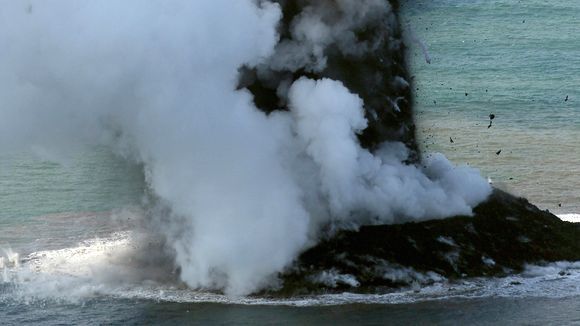 Cypressoïde plume and water vapor off
Nishino-shima 11/20/2013 - Phase two of the eruption - photo Getty images
Cypressoïde plume and water vapor off
Nishino-shima 11/20/2013 - Phase two of the eruption - photo Getty images
Phase 2 - hydromagmatic :
Air Force Japan has detected around 10 a.m. 20 November 2013 an ash plume
near Nishino -shima Island. The coast guards have confirmed the
eruption to 16 h, and the formation of a 200 meter wide circular island.
When the pressure of the water column is small enough to not be able to counteract the pressure generated by the lava fragments, the eruption  happening in his hydromagmatic phase.
happening in his hydromagmatic phase.
Under
the effect of heat shock generated by the encounter between water at a few degrees Celsius and the lava heated to over 1000°C, it breaks under the influence of explosions and the water vaporizes.
From the surface of the water then rises a volcanic plume composed mainly of water vapor but also of gas and volcanic ash, which can amount to thousands of meters. Sheaves of fragmented lava may also
pierce the surface of the water, while giving rise to so-called " cypressoïdes " plumes. Reverse accumulation of
pyroclastites, the volcano grows to emerge gradually and then completely, to the extent that the volcanic pipe opens above the water level .
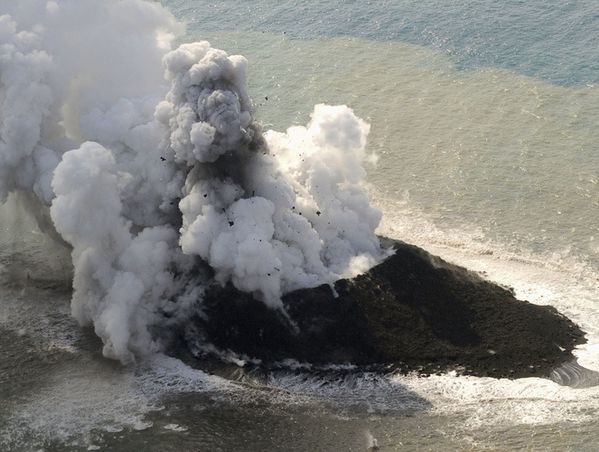 Nishino
-shima , the 11/21/2013 - formation of a tuff / slag cone - projections of bombs and gas and steam plume - photo Japan Daily Press
Nishino
-shima , the 11/21/2013 - formation of a tuff / slag cone - projections of bombs and gas and steam plume - photo Japan Daily Press
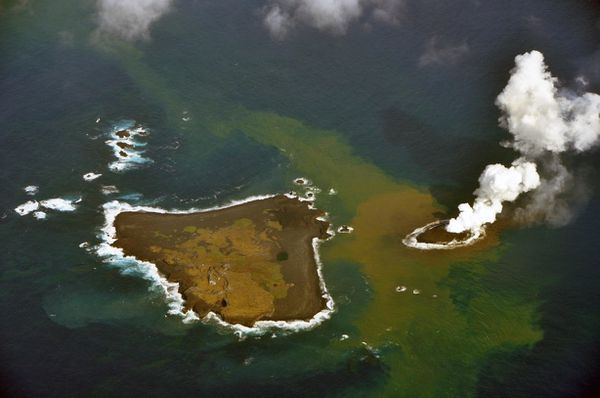
Nishino -shima , the 11/21/2013 - primitive island and the
nearest eruption, with the area of discoloration - Photo Japan Coast Guards
Phase 3 - Aerian :
The change in eruptive
style, from the explosive interaction between magma and water to the strombolian activity, occurred between 22 and 23 November .
Strombolian explosions project, along with a plume of ash , bombs and large lava fragments around the newly formed cone, which fall into the sea, degassing and steaming water that surrounds them
, creating the bubbling. On 24 November, a lava flow is seen on the
southeast flank of the new cone. Several vents are visible, assets in turn, on the
video below ( 24/11/2013 )
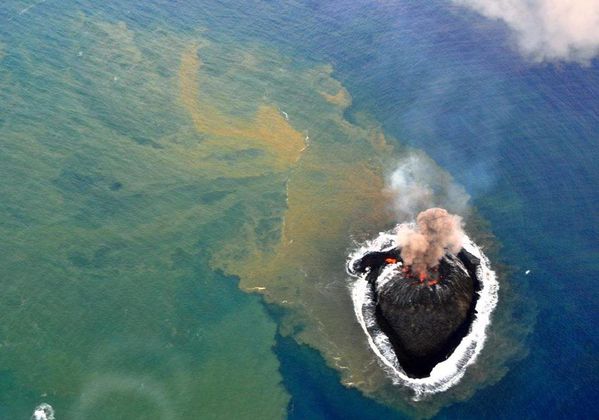 Nishino-shima - On 11.24.2013 , Strombolian explosive activity , accompanied by a plume of ash and lava - photo Japan Coast Guards
Nishino-shima - On 11.24.2013 , Strombolian explosive activity , accompanied by a plume of ash and lava - photo Japan Coast Guards
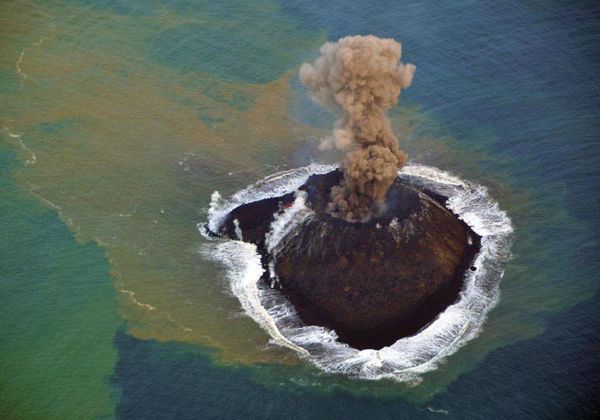 Nishino -shima on 11/24/2013 - another view - photo Japan Coast Guards
Nishino -shima on 11/24/2013 - another view - photo Japan Coast Guards
This magmatic activity will allow the formation of welded slag and lava flows, and its duration will determine the survival of the island facing the new marine erosion, and his sustainability
thereof after the cessation of eruption .
In early December, the eruptive activity continues ...his height progresses only slowly - it still exceeds 50 meters - due to moderate strombolian activity , but it grows towards the southeast,
several cast having created a platform .
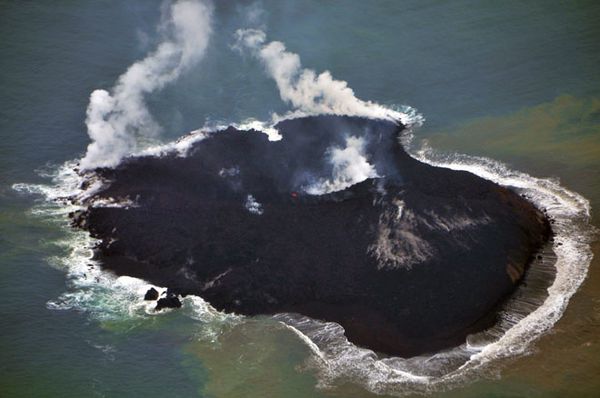 Nishino
-shima , the 01.12.2013 - on the right of the new island , traces of lava - background , plumes of steam illustrate the interaction between lava and seawater - an active
lava flow glowing in the center - photo Japan Coast Guards
Nishino
-shima , the 01.12.2013 - on the right of the new island , traces of lava - background , plumes of steam illustrate the interaction between lava and seawater - an active
lava flow glowing in the center - photo Japan Coast Guards
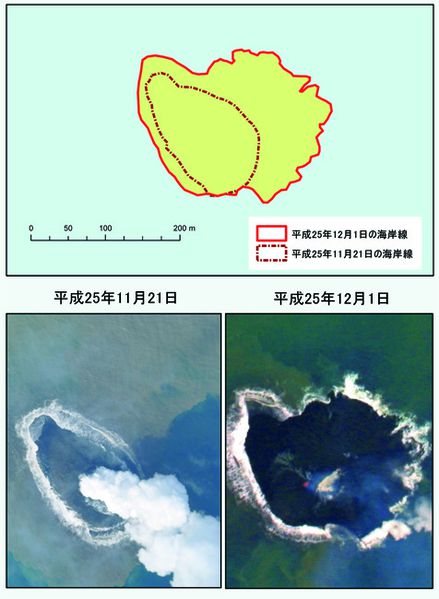 Diagram of the evolution of
the new island versus aerial photos - doc.JCG
Diagram of the evolution of
the new island versus aerial photos - doc.JCG
On a section of the island and the seabed, we
can see :
- Its evolution before the eruption of 1973 and currently
- In dark gray, the underwater and air intake of the eruption of 1973, which expanded the
island
- In red, the position of the eccentric eruption and the new cone.
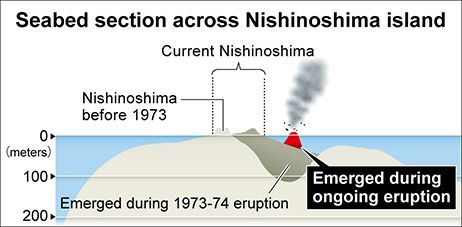 doc. Asahi
Shimbun
doc. Asahi
Shimbun
Sources :
- Global Volcanism Program - Nishino-shima
- Japan Coast Guards - Kaiho. mlit - link
Thème Magazine - Hébergé par Overblog


